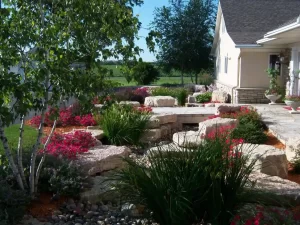Boulder Retaining Walls: Combining Functionality and Aesthetics
In the world of landscaping and outdoor design, boulder retaining walls have emerged as a popular and versatile solution. These impressive structures not only serve functional purposes but also add a touch of natural beauty to any landscape. Boulder retaining walls, often utilized to address slope variations, prevent soil erosion, and create multi-level terrains, have become a hallmark of creative and sustainable landscaping. In this article, we will explore the various facets of boulder retaining walls, highlighting their benefits and offering insights into their design and implementation.
1. Functionality and Stability: Boulder retaining walls are primarily known for their robustness and ability to hold back soil and prevent erosion. They are particularly useful in areas with uneven terrains or steep slopes, where traditional landscaping techniques might prove inadequate. The sheer mass and weight of the boulders provide a natural barrier against the forces of gravity and water, ensuring stability and durability over time.
2. Aesthetic Appeal: While functionality remains paramount, boulder retaining walls also bring a unique aesthetic charm to outdoor spaces. The rugged and irregular shapes of the boulders contrast with the surrounding landscape, creating an eye-catching focal point. Whether in a garden, along a driveway, or by a water feature, these walls can transform an ordinary area into a visually striking masterpiece.
3. Versatile Design Options: One of the remarkable features of working with natural stones is their adaptability to diverse design preferences. From rustic and earthy to modern and artistic, the choice of boulders and arrangement styles can align with various themes. Homeowners and designers can explore different sizes, shapes, and colors of boulders to achieve the desired look that seamlessly integrates with the environment.
4. Environmental Benefits: Boulder retaining walls align with sustainable landscaping practices. By preventing soil erosion, they contribute to maintaining the ecosystem’s balance. These walls reduce sediment runoff into water bodies, preventing water pollution and protecting aquatic life. Moreover, boulder retaining walls often allow for efficient water drainage, reducing the risk of water accumulation and its adverse effects.
5. Stairways and Multi-Level Terrains: In addition to their primary function as retaining structures, boulder walls can be ingeniously incorporated into stairways and multi-level terrains. Boulder retaining walls serve as an excellent foundation for creating elevated gardens or seating areas, maximizing the available space, and adding a unique dimension to the landscape. Integrating steps within the wall’s design ensures both functionality and aesthetics.
6. Longevity and Low Maintenance: Natural stones are known for their longevity and minimal maintenance requirements. Unlike certain man-made materials, boulders are naturally resilient to weather conditions and wear. Properly constructed walls can stand the test of time, requiring only occasional inspections to address any settling or adjustments.
In conclusion, Natural stone features epitomize the harmonious blend of functionality and aesthetics in landscaping. Their ability to serve as sturdy barriers against erosion, coupled with their innate beauty and adaptability, makes them a preferred choice for homeowners and landscape designers alike. From preventing soil erosion to creating captivating multi-level gardens, boulder retaining walls offer a range of benefits that enhance the visual appeal and sustainability of outdoor spaces. By understanding their design principles and leveraging their inherent features, individuals can transform their landscapes into captivating works of art while ensuring long-lasting stability.

Vist us on Facebook or for more Project ideas check this out
